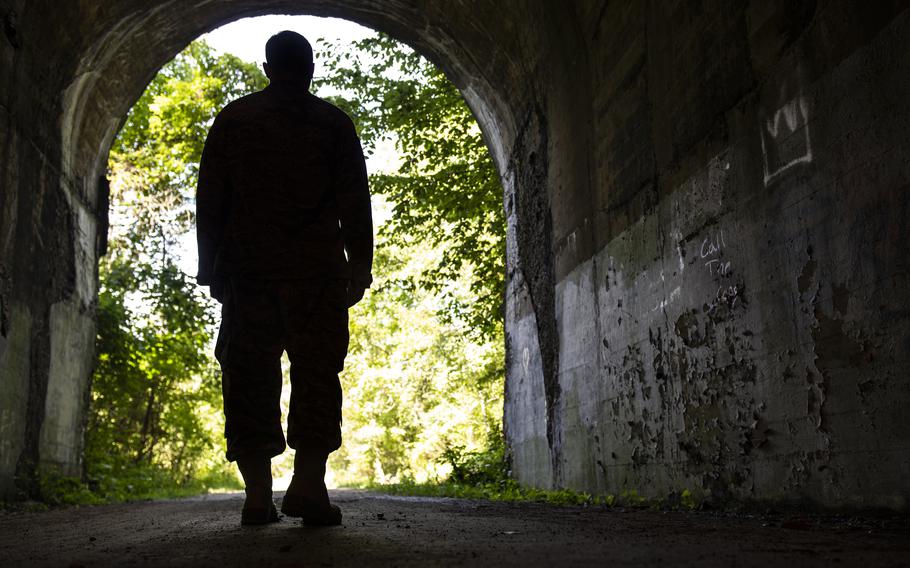
Category: If I was in Charge


Suicides in the active-duty military increased in the first three months of 2023 compared to the same time last year, according to a newly released Pentagon report. The Defense Suicide Prevention Office revealed in its quarterly report that the overall number of active-duty suicides — 94 — from January through March was up 25% compared to the number of troops — 75 — who took their own lives in the first three months of 2022. (Joshua J. Seybert/U.S. Air Force)
WASHINGTON — Suicides in the active-duty military increased in the first three months of 2023 compared to the same time last year, according to a newly released Pentagon report.
The Defense Suicide Prevention Office revealed in its quarterly report that the overall number of active-duty suicides — 94 — from January through March was up 25% compared to the number of troops — 75 — who took their own lives in the first three months of 2022.
“Every death by suicide is a tragedy,” according to the report. “Data includes all known or suspected suicides (both confirmed and pending) as of March 31, 2023.”
The Army had the greatest increase in suicide deaths, from 37 to 49. The Marine Corps increased from eight to 14. The Air Force had one additional suicide compared to 2022 and there was no change for the Navy or Space Force, the Defense Department report states.
The 94 active-duty suicides are the most that the military has seen since 97 were reported in the second quarter of 2021. Among reserve troops and the National Guard, the report said suicide figures did not change between the first quarter of 2022 and the same period this year.
Pentagon data have shown a rise in military suicides in the past decade, including a significant spike in 2020 during the coronavirus pandemic, and the Defense Department has spent millions of dollars on efforts to try to prevent them.
In May, the department enacted the long-awaited Brandon Act to let troops seek mental health services confidentially and any time that they need it. It’s named after Navy Petty Officer 3rd Class Brandon Caserta, who committed suicide in 2018. According to Defense Department data, there were almost 29 suicides per 100,000 troops in 2020 — up from 17.5 per 100,000 in 2010. That figure fell to 24.3 per 100,000 in 2021, but it still represented a serious uptick in suicides compared to most of the 2000s and 2010s.
“There is still a gradual increasing trend for suicide in the military over a 10-year period, and we need to see a sustained long-term reduction in suicide rates to know if we’re really making progress,” Beth Foster, executive director of the Pentagon’s Force Resiliency Office, said when the 2021 Annual Report on Suicide in the Military came out in the fall.
The Defense Suicide Prevention Office was created by a Pentagon task force in 2011 to find more effective suicide prevention methods. Earlier this year, the Pentagon’s Suicide Prevention and Response Independent Review Committee, after studying the problem for a year, made several recommendations, including restricting troops’ access to firearms, imposing waiting periods for gun and ammunition purchases and raising the minimum age for buying both to 25. Firearms are used in about two-thirds of all active-duty military suicides, according to the Defense Department. The Pentagon is reviewing the recommendations.
The second quarter ended June 30 and the Defense Suicide Prevention Office traditionally doesn’t issue an updated suicide report covering that period until October. The Pentagon’s comprehensive yearly study on military suicides also is typically released in October. This year’s will analyze 2022.
“The numbers presented in this report are preliminary and subject to change as previously unknown suicide cases are reported and some known cases are further investigated,” the four-page report states. “Caution should be used when making comparisons across groups and/or interpreting changes in suicide counts across time.”
In addition to Pentagon-wide programs, each of the military services has its own suicide program designed to provide help for troubled troops. Further, the national suicide prevention hotline was streamlined last year and became available by dialing 988. Pressing “1” after calling the number takes callers to the Veterans Crisis Line. Service members and veterans can also text 838255 or visit VeteransCrisisLine.net for help.
“There are instruments so dangerous to the rights of the nation and which place them so totally at the mercy of their governors that those governors, whether legislative or executive, should be restrained from keeping such instruments on foot but in well-defined cases. Such an instrument is a standing army.”—Thomas Jefferson, 1789
What does it say about the state of our freedoms that there are now more pencil-pushing, bureaucratic (non-military) government agents armed with weapons than U.S. Marines?
Among the agencies being supplied with night-vision equipment, body armor, hollow-point bullets, shotguns, drones, assault rifles and LP gas cannons are the IRS, Smithsonian, U.S. Mint, Health and Human Services, FDA, Small Business Administration, Social Security Administration, National Oceanic and Atmospheric Administration, Education Department, Energy Department, Bureau of Engraving and Printing and an assortment of public universities.
Add in the Biden Administration’s plans to swell the ranks of the IRS by 87,000 new employees (some of whom will be authorized to use deadly force) and grow the nation’s police forces by 100,000 more cops, and you’ve got a nation in the throes of martial law.
We’re being frog-marched into tyranny at the end of a loaded gun.
Make that hundreds of thousands of loaded guns.
According to the Wall Street Journal, the number of federal agents armed with guns, ammunition and military-style equipment, authorized to make arrests, and trained in military tactics has nearly tripled over the past several decades.
As Adam Andrzejewski writes for Forbes, “the federal government has become one never-ending gun show.”
While Americans have to jump through an increasing number of hoops in order to own a gun, federal agencies have been placing orders for hundreds of millions of rounds of hollow point bullets and military gear.
For example, the IRS has stockpiled 4,500 guns and five million rounds of ammunition in recent years, including 621 shotguns, 539 long-barrel rifles and 15 submachine guns.
The Veterans Administration purchased 11 million rounds of ammunition (equivalent to 2,800 rounds for each of their officers), along with camouflage uniforms, riot helmets and shields, specialized image enhancement devices and tactical lighting.
The Department of Health and Human Services acquired 4 million rounds of ammunition, in addition to 1,300 guns, including five submachine guns and 189 automatic firearms for its Office of Inspector General.
According to an in-depth report on “The Militarization of the U.S. Executive Agencies,” the Social Security Administration secured 800,000 rounds of ammunition for their special agents, as well as armor and guns.
The Environmental Protection Agency owns 600 guns. The Smithsonian now employs 620-armed “special agents.”
Even agencies such as Amtrak and NASA have their own SWAT teams.
Ask yourselves: why are government agencies being turned into military outposts?
What’s with the buildup of SWAT teams within non-security-related federal agencies? Even the Department of Agriculture, the Railroad Retirement Board, the Tennessee Valley Authority, the Office of Personnel Management, the Consumer Product Safety Commission, the U.S. Fish and Wildlife Service and the Education Department have their own SWAT teams. Most of those officers are under the command of either the Department of Homeland Security or the Department of Justice.
Why does the Department of Agriculture need .40 caliber semiautomatic submachine guns and hollow point bullets? For that matter, why do its agents need ballistic vests and body armor?
For that matter, why do IRS agents need AR-15 rifles?
Why do local police need armored personnel carriers with gun ports, compact submachine guns with 30-round magazines, precision battlefield sniper rifles, and military-grade assault-style rifles and carbines?
Why is the federal government distributing obscene amounts of military equipment, weapons and ammunition to police departments around the country?
Why is the military partnering with local police to conduct training drills around the country? And what exactly are they training for? The public has been disallowed from obtaining any information about the purpose of these realistic urban training drills, other than that they might be loud and to not be alarmed.
We should be alarmed.
As James Madison warned, “We are right to take alarm at the first experiment upon our liberties.”
Unfortunately, we’re long past the first experiment on our freedoms, and merely taking alarm over this build-up of military might will no longer suffice.
Nothing about this de facto army of bureaucratic, administrative, non-military, paper-pushing, non-traditional law enforcement agencies is necessary for national security.
Moreover, while these weaponized, militarized, civilian forces which are armed with military-style guns, ammunition and equipment; trained in military tactics; and authorized to make arrests and use deadly force—may look and act like the military, they are not the military.
Rather, they are foot soldiers of the police state’s standing army, and they are growing in number at an alarming rate.
This standing army—a.k.a. a national police force—vested with the power to completely disregard the Constitution and rule by force is exactly what America’s founders feared, and its danger cannot be overstated or ignored.
This is exactly what martial law looks like—when a government disregards constitutional freedoms and imposes its will through military force, only this is martial law without any government body having to declare it: Battlefield tactics. Militarized police. Riot and camouflage gear. Armored vehicles. Mass arrests. Pepper spray. Tear gas. Batons. Strip searches. Drones. Less-than-lethal weapons unleashed with deadly force. Rubber bullets. Water cannons. Concussion grenades. Intimidation tactics. Brute force. Laws conveniently discarded when it suits the government’s purpose.
The militarization of America’s police forces in recent decades, which has gone hand in hand with the militarization of America’s bureaucratic agencies, has merely sped up the timeline by which the nation is transformed into an authoritarian regime.
Now we find ourselves struggling to retain some semblance of freedom in the face of administrative, police and law enforcement agencies that look and act like the military with little to no regard for the Fourth Amendment, laws such as the NDAA that allow the military to arrest and indefinitely detain American citizens, and military drills that acclimate the American people to the sight of armored tanks in the streets, military encampments in cities, and combat aircraft patrolling overhead.
This quasi-state of martial law has been helped along by government policies and court rulings that have made it easier for the police to shoot unarmed citizens, for law enforcement agencies to seize cash and other valuable private property under the guise of asset forfeiture, for military weapons and tactics to be deployed on American soil, for government agencies to carry out round-the-clock surveillance, for legislatures to render otherwise lawful activities as extremist if they appear to be anti-government, for profit-driven private prisons to lock up greater numbers of Americans, for homes to be raided and searched under the pretext of national security, for American citizens to be labeled terrorists and stripped of their rights merely on the say-so of a government bureaucrat, and for pre-crime tactics to be adopted nationwide that strip Americans of the right to be assumed innocent until proven guilty and creates a suspect society in which we are all guilty until proven otherwise.
Don’t delude yourself into believing that this thinly-veiled exercise in martial law is anything other than an attempt to bulldoze what remains of the Constitution and reinforce the iron-fisted rule of the police state.
This is no longer about partisan politics or civil unrest or even authoritarian impulses.
This is a turning point.
As I make clear in my book Battlefield America: The War on the American People and in its fictional counterpart The Erik Blair Diaries, we are sliding fast down a slippery slope to a Constitution-free America.
If we are to have any hope of salvaging what’s left of our battered freedoms, we’d do well to start by disarming the IRS and the rest of the federal and state bureaucratic agencies, de-militarizing domestic police forces, and dismantling the police state’s standing army.
WC: 1308
ABOUT JOHN W. WHITEHEAD
Constitutional attorney and author John W. Whitehead is founder and president of The Rutherford Institute. His most recent books are the best-selling Battlefield America: The War on the American People, the award-winning A Government of Wolves: The Emerging American Police State, and a debut dystopian fiction novel, The Erik Blair Diaries. Whitehead can be contacted at staff@rutherford.org. Nisha Whitehead is the Executive Director of The Rutherford Institute. Information about The Rutherford Institute is available at www.rutherford.org.
—————————————————————————————-Its a nice dream but I am not holding my breath on this one! Grumpy
Ladies!


On Sunday, President Biden told a large assembly: “We must all work together to address the hate that remains a stain on the soul of America. . . . Our hearts are heavy once again, but the resolve must never, ever waver.”
He was responding, of course, to the mass shooting at the Tops Friendly Markets grocery store in Buffalo, New York, which left ten people dead and three injured.
The alleged shooter, 18-year-old Payton Gendron, drove several hours from his home in Conklin, New York, to a neighborhood and a market where shoppers were, in his estimation, most likely to be black. He was wearing tactical gear and armed with the Bushmaster XM-15 assault rifle he had bought legally in Endicott, New York, with the intention—reportedly detailed in his racist manifesto—to use it to shoot blacks.
Hate is not, as Biden labels it, an abstract stain on the soul of America. It is an idea that festers in the minds of violent people. It is our duty to get better at identifying and stopping these individuals before they hurt others.
And we can get better at identifying and stopping them.
Gendron had been actively ranting online about his hatred for blacks. He took inspiration from racist conspiracy theories on online message boards and explicitly identified himself as a fascist, white supremacist, racist, and anti-Semite. On the Internet, he had detailed plans to carry out a shooting targeting blacks similar to the one he wound up perpetrating in Buffalo.
Similarly, Frank James, the black man who traveled to New York from Philadelphia last month to shoot up ten passengers on a rush hour subway, had been raging online for a decade about blacks, whites, Latinos, and Jews. He also fumed against New York mayor Eric Adams and the city’s subway system and alluded to leaving Philadelphia to take action. And Robert Gregory Bowers had written colorfully about his intention to attack Jews (and his murderous hatred for blacks) before driving to Pittsburgh’s Tree of Life Synagogue in 2018 and massacring 11 worshippers.
We should be devoting more resources both to intelligence-gathering about action-oriented violent rhetoric online and to the manpower needed to follow up on all such threats. These types of investigations, occurring in both federal and local agencies, are resource- and training-intensive.
Violently manifested hate is definitely growing. Anti-Semitic incidents broke records in 2021, and anti-Asian hate crimes have broken records for the past two years. In New York City, the country’s epicenter for hate crimes (thanks, in part, to its demographic diversity), crimes against blacks and gay men have doubled since last year. Who perpetrates these crimes? Whites, blacks, Latinos—it’s a sickness that crosses all racial and ethnic boundaries.
One commonality among attackers is a high degree of mental illness. As announced this month at a New York City Council hearing, police designated nearly half of all hate-crime arrestees as emotionally disturbed. The NYPD admitted that it wasn’t doing enough to track whether these suspects receive treatment or to coordinate with mental-health professionals.
High-risk mental illness was a known issue for Gendron, whom state police brought to a hospital last June after he wrote in high school about wanting to shoot people. The hospital released him a day and a half later. This story is tragically familiar. In 2017, Martial Simon reportedly “told a psychiatrist at the state-run Manhattan Psychiatric Center that it was just a matter of time before he pushed a woman to the train tracks.” This past January, he pushed Deloitte executive Michelle Go to her death from a Times Square subway platform.
In addition to these gaps in psychiatric oversight for individuals who have voiced an intention of committing violence, states including New York have reduced in-patient psychiatric beds dramatically. Sweeping criminal-justice reforms have hampered judges’ ability to induce unbalanced offenders into psychiatric care as a means of avoiding jail time.
Policymakers at all levels need to prioritize closing these gaps between police, prosecutors, and psychiatric practitioners and ensuring that sufficient spaces are available for the small but critical segment of the population that requires long-term supervision. As the president said, our hearts are heavy. Now let’s use our heads.

